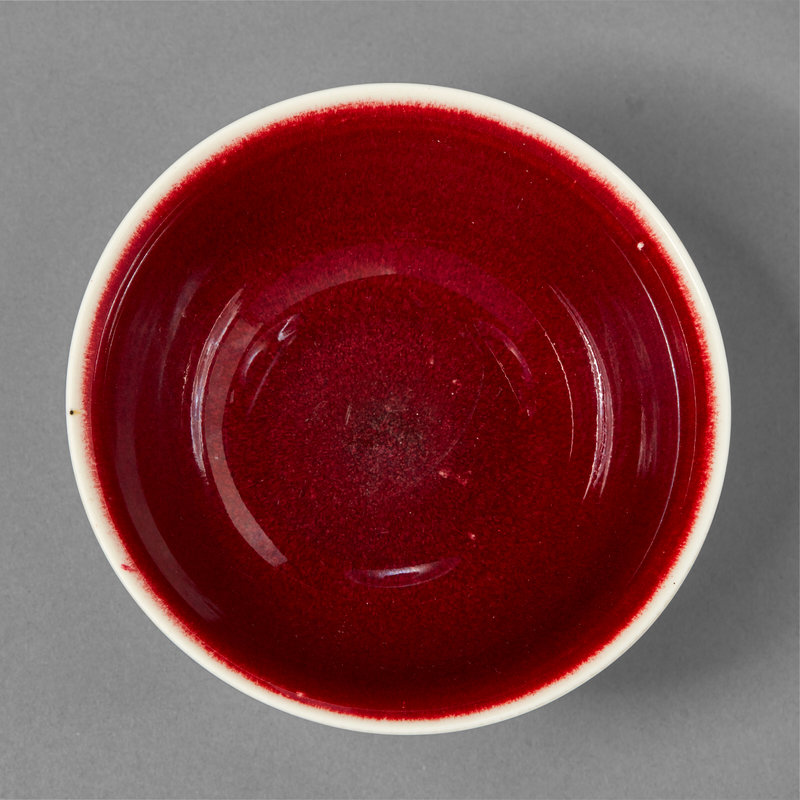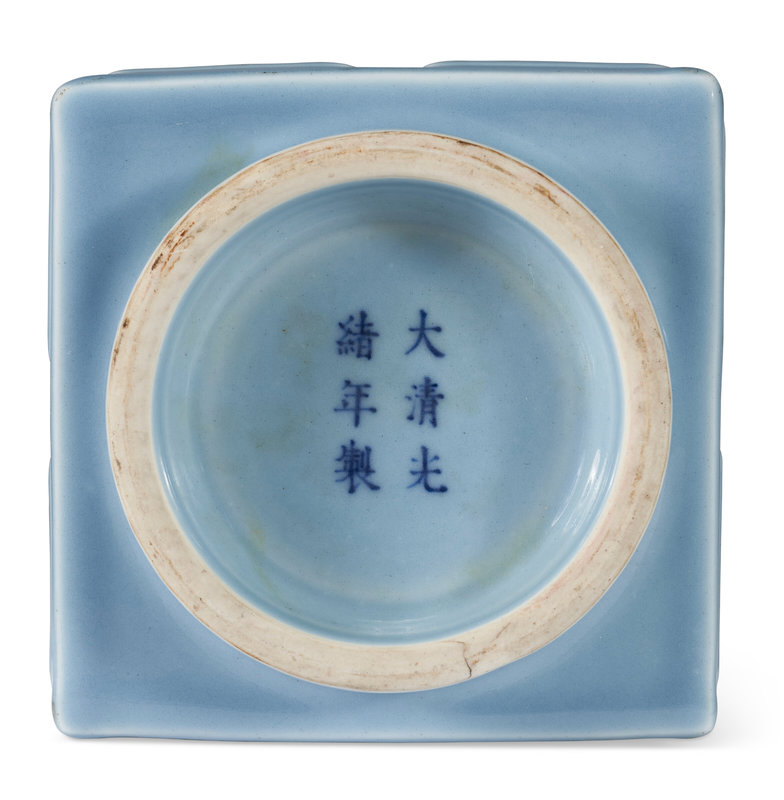Provenance: K. W. Woollcombe-Boyce (b. 1888) Collection, no. 75.
Bluett's or Sparks, London.
M. Schnelling Collection, London, 1960s.
Anthony Schnelling Collection, New York.
Lot 1057. A café-au-lait-glazed bowl, Kangxi six-character mark in underglaze blue within a double circle and of the period (1662-1722); 11.1 cm diam., Japanese wood box. Price realised USD 8,190 (Estimate USD 8,000 – USD 12,000). © Christie's Images Ltd 2023
Lot 1058. A very rare incised clair-de-lune-glazed hu-form vase, Kangxi six-character mark in underglaze blue and of the period (1662-1722); 11.1 cm diam., Japanese wood box. Price realised USD 8,190 (Estimate USD 8,000 – USD 12,000). © Christie's Images Ltd 2023
Note: A slightly larger (22.5 cm. high) Kangxi-marked clair-de-lune vase of nearly identical shape and decoration is in the collection of the Palace Museum, Beijing, and is illustrated in Gugong bowuyuan cang gu taoci ziliao xuan cui (Selected Collection of Ancient Ceramics in the Palace Museum), vol. 2, Beijing, 2005, p. 128, no. 106.
Lot 1058. A rare celadon-glazed cylindrical vase, Yongzheng six-character mark in underglaze blue within a double circle and of the period (1723-1735); 26.4 cm high, cloth box. Price realised USD 8,190 (Estimate USD 8,000 – USD 12,000). © Christie's Images Ltd 2023
Provenance: Sotheby’s Hong Kong, 3-4 May 1994, lot 109.
Note: The glaze on this vase is particularly lovely, being of a clear, soft, even, pale celadon. Chinese celadon glazes were appreciated by connoisseurs as early as the Tang dynasty, when the writer Lu Yu (AD 733-804), declared in his Cha jing (Tea Classic) that Yue ware celadon bowls were the best vessels from which to drink fine tea. This admiration for celadon glazes on stoneware vessels continued into the Song dynasty, when they dominated court taste. Celadon-type glazes were applied to porcelain vessels produced at Jingdezhen in the early Ming period, but it was the Qing-dynasty potters of the Kangxi reign who perfected a particularly delicate version of the glaze applied to a very white (low iron) porcelain body. The delicate celadon glaze was colored using only about half the amount of iron found in typical Song-dynasty Longquan celadons, and was further modified in the Yongzheng period to produce the even more finely textured and slightly bluer pale celadon glaze as seen on the current vase. These celadons and the others created with minute variations in tone and texture have been much admired by Chinese connoisseurs and have been given names such as douqing (bean green) and dongqing (eastern green) in the Kangxi reign, and dongqing (winter green) and fenqing (soft green) in the Yongzheng reign. The current vase has a particularly beautiful fenqing glaze.
A Yongzheng blue and white vase and cover of similar size and shape as the current vase, decorated with sprays of auspicious fruit, in the Palace Museum, Beijing, is illustrated in The Complete Collection of Treasures of the Palace Museum - 36 - Blue and white Porcelain with Underglaze Red (II), Hong Kong, 2000, p. 118, no. 104.
Lot 1063. A copper-red-glazed stem bowl, 17th-18th century; 36.7 cm diam., mahogany stand. Price realised USD 138,600 (Estimate USD 6,000 – USD 8,000). © Christie's Images Ltd 2023
Provenance: The J. M. Hu (1911-1995), Zande Lou Collection.
Lot 1055. A small copper-red-glazed vase, meiping, 18th century; 19 cm high, cloth box. Price realised USD 16,380 (Estimate USD 6,000 – USD 8,000). © Christie's Images Ltd 2023
Provenance: Frank Caro (1904-1980), New York (according to label).
Lot 1063. A rare large Ge-type hu-form vase, Qianlong seal mark in underglaze blue andof the period (1736-1795); 31.5 cm high, Japanese wood box. Price realised USD 138,600 (Estimate USD 150,000 – USD 250,000). © Christie's Images Ltd 2023
Provenance: Osaka Bijitsu Club auction, early 20th century.
Tsuchihashi Collection, Tokyo.
Kyoto Bijitsu Club auction, before World War II.
Note: The glaze on this vase is based on one of the five famous wares of the Song dynasty—Ge ware. All five (the other four being Ru, Guan, Ding and Jun) were greatly admired by the emperors of the high Qing, and during the Yongzheng reign much research and development was undertaken in order to reproduce these glazes on the porcelains made at the imperial kilns at Jingdezhen. Like his father, the Qianlong Emperor was fascinated by antiques and encouraged the craftsmen working for the court to reproduce them. The fondness for antiquarianism is also evident in the shape, as this vase is potted after an archaic bronze hu vessel with a broad waisted neck and ribbed globular body. Monochrome vases of this type have been recorded with a variety of crackle glazes, including one Guan-type example sold at Christie’s Hong Kong, 28 November 2005, lot 1327, and a Ru-type example exhibited in the National Palace Museum, Taipei, Special Exhibition of Qing Dynasty Monochrome Glazed Porcelain, 1981, no. 88. See also the Yongzheng-marked blue and white example sold at Sotheby's, Hong Kong, 11 April 2008, lot 3067.
Lot 1086. A large blue-glaze vase, meiping, 18th-19th century; 31.5 cm high, Japanese wood box. Price realised USD 12,600 (Estimate USD 10,000 – USD 15,000). © Christie's Images Ltd 2023
Lot 1087. A pale blue-glaze cong-form 'Eight trigrams' vase, Guangxu six-character mark in underglaze blue within a double circle and of the period (1875-1908); 28.5 cm high. Price realised USD 20,160 (Estimate USD 6,000 – USD 8,000). © Christie's Images Ltd 2023
Christie's. Important Chinese Ceramics and Works of Art, New York, 23 March - 24 March 2023

/https%3A%2F%2Fprofilepics.canalblog.com%2Fprofilepics%2F1%2F0%2F100183.jpg)
/https%3A%2F%2Fstorage.canalblog.com%2F03%2F02%2F119589%2F96711876_o.jpg)
/https%3A%2F%2Fstorage.canalblog.com%2F11%2F31%2F119589%2F94773502_o.jpg)
/https%3A%2F%2Fstorage.canalblog.com%2F20%2F83%2F119589%2F94772815_o.jpg)
/https%3A%2F%2Fstorage.canalblog.com%2F26%2F72%2F119589%2F75604929_o.jpg)
/https%3A%2F%2Fstorage.canalblog.com%2F59%2F60%2F119589%2F26458628_o.jpg)




































/http%3A%2F%2Fstorage.canalblog.com%2F25%2F58%2F119589%2F126352018_o.jpg)
/http%3A%2F%2Fstorage.canalblog.com%2F46%2F68%2F119589%2F121346168_o.jpg)
/image%2F1371349%2F20240331%2Fob_0d7487_2024-nyr-22642-0859-000-an-unusual-sma.jpg)
/image%2F1371349%2F20240331%2Fob_a6f470_2024-nyr-22642-0857-000-a-large-black.jpg)